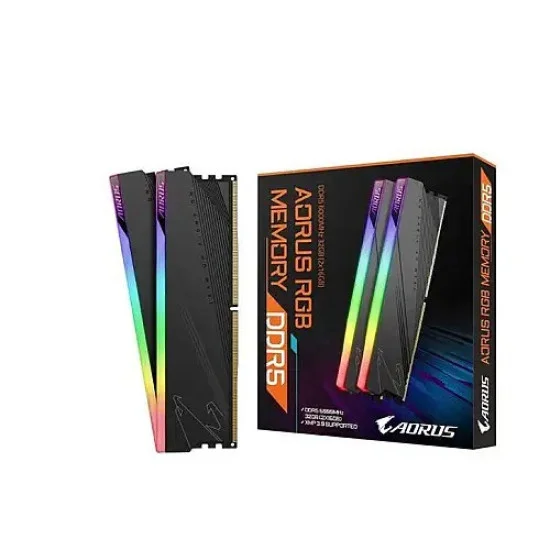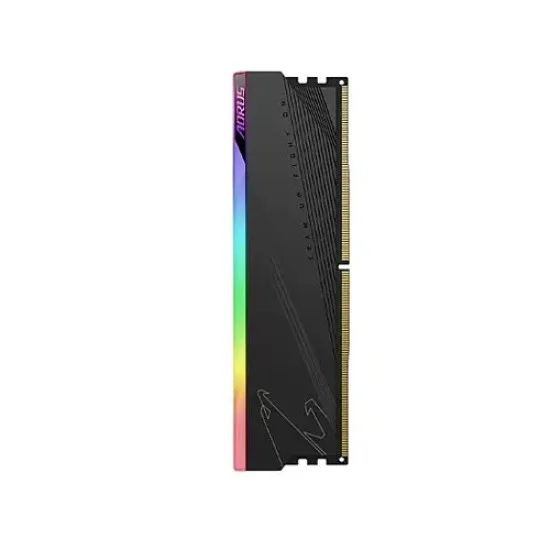GIGABYTE AORUS RGB 32GB RAM is a powerhouse addition to any desktop setup, designed to elevate your computing experience to new heights. Crafted with cutting-edge DDR5 technology, this memory module ensures lightning-fast performance, delivering an impressive bus speed of 6000MT/s. Whether you’re a hardcore gamer, content creator, or multitasking enthusiast, this RAM caters to your demanding needs with ease. With a storage capacity of 32GB spread across two 16GB modules, you’ll have ample space to run multiple applications simultaneously without compromising on speed or efficiency. The dual-channel kit optimizes data transfer rates, allowing for seamless multitasking and smoother overall system performance.Engineered for reliability and stability, this RAM features a low-latency design with SPD latency of 40-40-40-77 and tested latency of 40-40-40-76. This ensures rapid response times and reduced lag, even during intensive tasks or gaming sessions.
“” has been added to your cart. View cart
GIGABYTE AORUS RGB 32GB RAM (2 X 16GB) DDR5 6000MHZ DESKTOP RAM
| Memory | |
| Memory Type | 288-Pin PC RAM |
| Bus Speed | 6000MT/S |
| Latency | SPD Latency: 40-40-40-77 Tested Latency: 40-40-40-76 |
| Heat Sink Type | Heat Spreader |
| Storage | |
| Capacity | 32GB Kit (2x16GB) |
| Battery And Power | |
| SPD Voltage | 1.1V |
| Voltage | 1.35V |
| Ports | |
| Number-Of-Pin | 288 |
| Technical Info | |
| SPD Speed | 4800MT/S |
| Special Features | |
| Features | Dual Channel Kit |
| Physical Specification | |
| Color | AORUS Gray |
| Dimension | 6.42 X 5.24 X 0.59 Inches |
| Others | |
| Other Features | LED Color: RGB |
| Warranty Information | |
| Warranty | Limited Lifetime |
14,000.00৳
5
People watching this product now!
Product Description
Customer Reviews
Rated 0 out of 5
0 reviews
Rated 5 out of 5
0
Rated 4 out of 5
0
Rated 3 out of 5
0
Rated 2 out of 5
0
Rated 1 out of 5
0
Be the first to review “GIGABYTE AORUS RGB 32GB RAM (2 X 16GB) DDR5 6000MHZ DESKTOP RAM” Cancel reply
Online Sports Nutrition and Natural Dietetics.
Chances are there wasn't collaboration, communication, and checkpoints, there wasn't a process agreed upon or specified with the granularity required. It's content strategy gone awry right from the start. Forswearing the use of Lorem Ipsum wouldn't have helped, won't help now. It's like saying you're a bad designer, use less bold text, don't use italics in every other paragraph. True enough, but that's not all that it takes to get things back on track.
The villagers are out there with a vengeance to get that Frankenstein
You made all the required mock ups for commissioned layout, got all the approvals, built a tested code base or had them built, you decided on a content management system, got a license for it or adapted:
- The toppings you may chose for that TV dinner pizza slice when you forgot to shop for foods, the paint you may slap on your face to impress the new boss is your business.
- But what about your daily bread? Design comps, layouts, wireframes—will your clients accept that you go about things the facile way?
- Authorities in our business will tell in no uncertain terms that Lorem Ipsum is that huge, huge no no to forswear forever.
- Not so fast, I'd say, there are some redeeming factors in favor of greeking text, as its use is merely the symptom of a worse problem to take into consideration.
- Websites in professional use templating systems.
- Commercial publishing platforms and content management systems ensure that you can show different text, different data using the same template.
- When it's about controlling hundreds of articles, product pages for web shops, or user profiles in social networks, all of them potentially with different sizes, formats, rules for differing elements things can break, designs agreed upon can have unintended consequences and look much different than expected.
This is quite a problem to solve, but just doing without greeking text won't fix it. Using test items of real content and data in designs will help, but there's no guarantee that every oddity will be found and corrected. Do you want to be sure? Then a prototype or beta site with real content published from the real CMS is needed—but you’re not going that far until you go through an initial design cycle.




















Reviews
Clear filtersThere are no reviews yet.